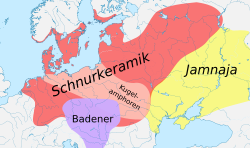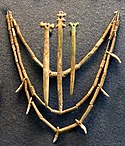Indo-European migrations
Autor/Urheber:
Attribution:
Das Bild ist mit 'Attribution Required' markiert, aber es wurden keine Informationen über die Attribution bereitgestellt. Vermutlich wurde bei Verwendung des MediaWiki-Templates für die CC-BY Lizenzen der Parameter für die Attribution weggelassen. Autoren und Urheber finden für die korrekte Verwendung der Templates hier ein Beispiel.
Shortlink:
Quelle:
Größe:
1200 x 598 Pixel (2388591 Bytes)
Beschreibung:
Animated map of Indo-European migrations. Sources:
- J.P. Mallory (1999) "In Search of the Indo-Europeans"
- D. Anthony (2007) "The Horse, The Wheel and Language"
- Allentoft et al. (2015) "Population genomics of bronze Age Eurasia", Nature, 11 june 2015, vol. 522
- Haak et al. (2015) "Massive migration from the steppe was a source for Indo-European languages in Europe", Nature, 522: 207–211
Lizenz:
Relevante Bilder
Relevante Artikel
Jamnaja-KulturDie Jamnaja-Kultur ist eine osteuropäische archäologische Kultur der späten Kupferzeit und frühen Bronzezeit im Gebiet um die Flüsse Dnister, Bug und Ural in der pontischen Steppe. Hermann Parzinger datierte sie (2006) auf 3600 bis 2500 v. Chr. Die Jamnaja-Kultur wird von Marija Gimbutas und anderen als ein wichtiger Teil des Komplexes „Kurgan-Kultur“ bezeichnet. .. weiterlesen








